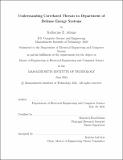| dc.contributor.advisor | Roozbehani, Mardavij | |
| dc.contributor.author | Adams, Katherine E. | |
| dc.date.accessioned | 2022-01-14T15:07:50Z | |
| dc.date.available | 2022-01-14T15:07:50Z | |
| dc.date.issued | 2021-06 | |
| dc.date.submitted | 2021-11-02T13:44:53.332Z | |
| dc.identifier.uri | https://hdl.handle.net/1721.1/139375 | |
| dc.description.abstract | Climate change poses an existential threat to the United States military’s energy systems. We researched current trends in energy, economics, and weather, translating those trends into quantifiable threats to the military’s secondary power systems. We also assembled a data set about secondary power systems on domestic U.S. military bases. Because that data set was missing critical information, we formulated and then evaluated an imputation method to complete the data set. This imputation method successfully predicted expected cost for the missing installation data. We ran simulations using our quantified trends and data set on existing software to predict the effects of those trends on certain U.S. military bases. Ultimately, we identified threats that could potentially cost 150 million dollars and cause more than a week of additional electrical downtime for those select bases. | |
| dc.publisher | Massachusetts Institute of Technology | |
| dc.rights | In Copyright - Educational Use Permitted | |
| dc.rights | Copyright MIT | |
| dc.rights.uri | http://rightsstatements.org/page/InC-EDU/1.0/ | |
| dc.title | Understanding Correlated Threats to Department of
Defense Energy Systems | |
| dc.type | Thesis | |
| dc.description.degree | M.Eng. | |
| dc.contributor.department | Massachusetts Institute of Technology. Department of Electrical Engineering and Computer Science | |
| mit.thesis.degree | Master | |
| thesis.degree.name | Master of Engineering in Electrical Engineering and Computer Science | |
